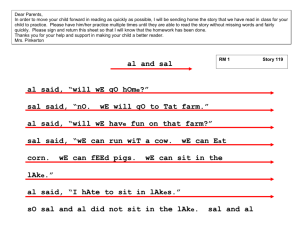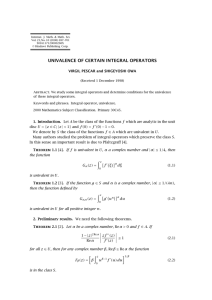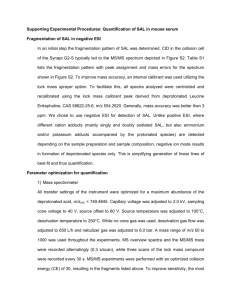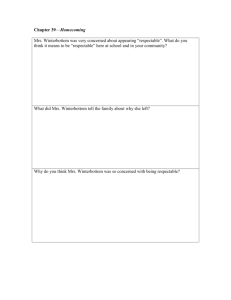On the Univalence of Some Integral Operators Virgil Pescar 1
advertisement
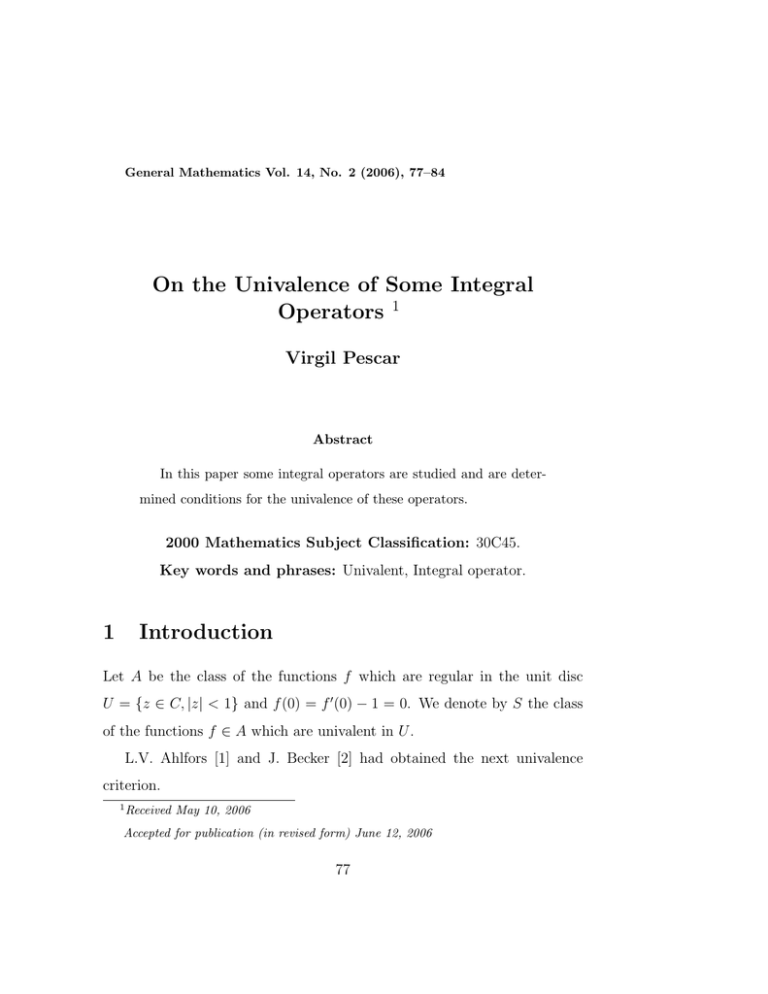
General Mathematics Vol. 14, No. 2 (2006), 77–84
On the Univalence of Some Integral
Operators 1
Virgil Pescar
Abstract
In this paper some integral operators are studied and are determined conditions for the univalence of these operators.
2000 Mathematics Subject Classification: 30C45.
Key words and phrases: Univalent, Integral operator.
1
Introduction
Let A be the class of the functions f which are regular in the unit disc
U = {z ∈ C, |z| < 1} and f (0) = f 0 (0) − 1 = 0. We denote by S the class
of the functions f ∈ A which are univalent in U .
L.V. Ahlfors [1] and J. Becker [2] had obtained the next univalence
criterion.
1
Received May 10, 2006
Accepted for publication (in revised form) June 12, 2006
77
78
Virgil Pescar
Theorem A.
Let c be a complex number, |c| ≤ 1, c 6= −1. If
f (z) = z + a2 z 2 + . . . is a regular function in U and
¯
¯
¯ 2 ¡
¢ zf 00 (z) ¯
2
¯ ≤ 1,
¯c|z| + 1 − |z|
(1)
¯
f 0 (z) ¯
for all z ∈ U, then the function f (z) is regular and univalent in U.
Further, V. Pescar [6] gave
Theorem B. Let α be a complex number, Reα > 0, and c a complex
number, |c| ≤ 1, c 6= −1 and f (z) = z + · · · a regular function in U . If
¯
¯
¯ 2α ¡
¢ 00 ¯
2α zf (z) ¯
¯
(2)
≤ 1,
¯c|z| + 1 − |z|
αf 0 (z) ¯
for all z ∈ U , then the function
¸ α1
· Z z
α−1 0
u f (u)du = z + . . . ,
(3)
Fα (z) = α
0
is regular and univalent in U .
In this paper we will need the following theorems.
Theorem C. [5] Let f ∈ A satisfy the condition
¯ 2 0
¯
¯ z f (z)
¯
¯
¯
(4)
¯ f 2 (z) − 1¯ < 1, z ∈ U,
then f is univalent in U .
Theorem D. [8] Let α be a complex number, Reα > 0 and c a complex
number, |c| ≤ 1, c 6= −1 and f ∈ A. If
¯
¯
1 − |z|2Reα ¯¯ zf 00 (z) ¯¯
(5)
¯ f 0 (z) ¯ ≤ 1 − |c|,
Reα
for all z ∈ U , then for any complex number β, Reβ ≥ Reα, the function
· Z z
¸ β1
β−1 0
(6)
Fβ (z) = β
u
f (u)du
0
On the Univalence of Some Integral Operators
79
is in the class S.
Schwarz Lemma.
UR = {z ∈ C :
[3]
Let f (z) the function regular in the disk
|z| < R}, with |f (z)| < M, M fixed. If f (z) has in
z = 0 one zero with multiply ≥ m, then
(7)
|f (z)| ≤
M m
|z| , z ∈ UR
Rm
the equality (in (7) for z 6= 0) can hold only if f (z) = eiθ RMm z m , where θ is
constant.
2
Main results
Theorem 1. Let the function g ∈ A satisfy (4), M be a positiv real number
£ +1 2M +1 ¤
fixed and c be a complex number. If α ∈ 2M
, 2M ,
2M +2
¯
¯
¯α − 1¯
¯ (2M + 1), c 6= −1
(8)
|c| ≤ 1 − ¯¯
α ¯
and
(9)
|g(z)| ≤ M
for all z ∈ U , then the function
(10)
¸ α1
· Z z
α−1
Gα (z) = α
[g(u)] du]
0
is in the class S.
Proof. From (10) we have
(11)
" Z
Gα (z) = α
z
0
µ
uα−1
g(u)
u
# α1
¶α−1
du
.
80
Virgil Pescar
Let us consider the function
Z
(12)
z
f (z) =
0
µ
g(u)
u
¶α−1
du.
The function f is regular in U .
³ ´α−1
³ ´α−2
g(z)
00
From (12) we get f 0 (z) = g(z)
,
f
(z)
=
(α
−
1)
z
z
zg 0 (z)−g(z)
z2
and
(13)
¯
¯
¯ 2α ¡
¢ zf 00 (z) ¯
2α
¯c|z| + 1 − |z|
¯=
¯
αf 0 (z) ¯
¯
µ
¶¯
¯ 2α ¡
¯
¢ α − 1 zg 0 (z)
2α
= ¯¯c|z| + 1 − |z|
− 1 ¯¯ ≤
α
g(z)
¯
¯ µ¯
¯
¶
¯ α − 1 ¯ ¯ z 2 g 0 (z) ¯ |g(z)|
¯ ¯
¯
≤ |c| + ¯¯
+1
α ¯ ¯ g 2 (z) ¯ |z|
for all z ∈ U .
We have g(0) = 0 and |g(z)| < M and by the Schwarz-Lemma we obtain
|g(z)| < M |z|. Using (13), we have
¯
¯
00
¯ 2α ¡
¯
¢
zf
(z)
¯c|z| + 1 − |z|2α
¯≤
(14)
¯
αf 0 (z) ¯
¯ ·µ¯
¯
¯
¶
¸
¯ α − 1 ¯ ¯ z 2 g 0 (z)
¯
¯
¯
¯
¯
≤ |c| + ¯
− 1¯ + 1 M + 1
α ¯ ¯ g 2 (z)
From (14) and since g satisfies the condition (4) we have
¯
¯
¯
¯
¯ 2α ¡
¯α − 1¯
¢ 00 ¯
2α zf (z) ¯
¯
¯
¯ (2M + 1)
(15)
≤ |c| + ¯
¯c|z| + 1 − |z|
αf 0 (z) ¯
α ¯
£ +1 2M +1 ¤
For α ∈ 2M
, 2M we have
2M +2
¯
¯
¯α − 1¯
¯ (2M + 1) ≤ 1
(16)
|c| ≤ 1 − ¯¯
α ¯
and, hence, we get
¯
¯
¯ 2α ¡
¢ 00 ¯
2α zf (z) ¯
¯
≤ 1, z ∈ U.
(17)
¯c|z| + 1 − |z|
αf 0 (z) ¯
On the Univalence of Some Integral Operators
for all z ∈ U .
³
From (12) we have f 0 (z) =
g(z)
z
´α−1
81
and by Theorem B for α real
number, α > 0, it results that the function Gα is in the class S.
Theorem 2.
Let g ∈ A, α be a real number, α ≥ 1, and c a complex
number, |c| ≤ α1 , c 6= −1. If
¯ 00 ¯
¯ g (z) ¯
¯
¯
¯ g 0 (z) ¯ ≤ 1, z ∈ U
(18)
then the function
Z
(19)
z
Hα (z) = {α
[ug 0 (u)]
α−1
1
du} α
0
is in the class S.
Proof. We observe that
· Z
Hα (z) = α
(20)
z
α−1
uα−1 (g 0 (u))
du
¸ α1
0
Let us consider the function
Z
(21)
z
p(z) =
α−1
[g 0 (u)]
du.
0
The function p is regular in U .
From (21) we have
α−1
p0 (z) = (g 0 (z))
α−2
, p00 (z) = (α − 1) [g 0 (z)]
g 00 (z)
and we obtain
(22)
¯
¯ ¯
¯
¯ 2α ¡
¯
¡
¢ 00
¢ 00 ¯ ¯
¯c|z| + 1 − |z|2α zp (z) ¯ = ¯c|z|2α + 1 − |z|2α zg (z) α − 1 ¯ .
¯
αp0 (z) ¯ ¯
g 0 (z) α ¯
82
Virgil Pescar
From (22), (18) and the conditions of theorem we get
¯
µ
¶¯
00
¯ 2α
¯
zp
(z)
2α
¯c|z| + 1 − |z|
¯ ≤ |c| + α − 1 ≤ 1
(23)
¯
0
αp (z) ¯
α
for all z ∈ U .
By Theorem B for α real number, α ≥ 1, and since p0 (z) = [g 0 (z)]α−1 it
results that the function Hα is in the class S.
Theorem 3. Let g ∈ A satisfies (4), α be a complex number, M > 1 fixed,
Reα > 0 and c be a complex number, |c| < 1. If
(24)
|g(z)| ≤ M
for all z ∈ U, then for any complex number β
(25)
Reβ ≥ Reα ≥
2M + 1
|α| (1 − |c|)
the function
" Z
Hβ (z) = β
(26)
z
µ
uβ−1
0
g(u)
u
¶ α1
# β1
.
du
is in the class S.
Proof. Let us consider the function
¶1
Z zµ
g(u) α
(27)
f (z) =
du.
u
0
The function f is regular in U. From (27) we have:
µ
0
f (z) =
g(z)
z
¶ α1
,
1
f (z) =
α
00
µ
g(z)
z
1
¶ α−1
zg 0 (z) − g(z)
z2
On the Univalence of Some Integral Operators
83
and
(28)
¯
¯
1 − |z|2Reα ¯¯ zf 00 (z) ¯¯ 1 − |z|2Reα
¯ f 0 (z) ¯ ≤ |α|Reα
Reα
¯ 0 ¯
¯ zg (z) ¯ 1 − |z|2Reα
¯
¯
¯ g(z) ¯ + |α|Reα
for all z ∈ U and hence, we have
¯
¯
¯ ¯
¯
µ¯
¶
1 − |z|2Reα ¯¯ zf 00 (z) ¯¯ 1 − |z|2Reα ¯¯ z 2 g 0 (z) ¯¯ ¯¯ g(z) ¯¯
(29)
¯ f 0 (z) ¯ ≤ |α|Reα
¯ g 2 (z) ¯ · ¯ z ¯ + 1
Reα
for all z ∈ U.
By the Schwarz-Lemma also |g(z)| ≤ M |z|, z ∈ U and using (29) we
obtain
(30)
¯
¯
¯
µ¯
¶
¯
1 − |z|2Reα ¯¯ zf 00 (z) ¯¯ 1 − |z|2Reα ¯¯ z 2 g 0 (z)
¯
¯ f 0 (z) ¯ ≤ |α|Reα
¯ g 2 (z) − 1¯ + 1 M + 1
Reα
for all z ∈ U.
From (30) and since g satisfies the condition (4) we get
¯
¯
1 − |z|2Reα ¯¯ zf 00 (z) ¯¯ 1 − |z|2Reα 2M + 1
2M + 1
(31)
≤
≤
¯
¯
0
Reα
f (z)
Reα
|α|
|α|Reα
for all z ∈ U.
From (25) we have
2M +1
|α|Reα
≤ 1 − |c| and using (31) we obtain
¯
¯
1 − |z|2Reα ¯¯ zf 00 (z) ¯¯
(32)
¯ f 0 (z) ¯ ≤ 1 − |c|.
Reα
³ ´ α1
0
From (27) we obtain f (z) = g(z)
and using (32) by Theorem D we
z
conclude that the function Hβ is in the class S.
References
[1] L. V. Ahlfors, Sufficient conditions for quasiconformal extension, Proc.
1973, Conf. Univ. of Maryland, Ann. of Math. Studies 79 [1973], 23-29.
84
Virgil Pescar
[2] J. Becker, Lownersche Differential gleichung und Schlichteits-Kriterion,
Math. Ann. 202, 4(1973), 321-335.
[3] O. Mayer, The functions theory of one variable complex, Bucureşti, 1981.
[4] Z. Nehari, Conformal mapping, Mc Graw-Hill Book Comp., New York,
1952 (Dover. Publ. Inc., 1975)
[5] S. Ozaki, M. Nunokawa,The Schwarzian derivative and univalent functions, Proc. Amer. Math. Soc. 33(2), 1972, 392-394.
[6] V. Pescar, A new generalization of Ahlfors 0 s and Becker 0 s criterion of
univalence, Bull. Malaysian Math. Soc. (Second Series) 19 (1996), 53-54.
[7] V. Pescar, New univalence criteria, ”Transilvania” University of Braşov,
Braşov, 2002.
[8] V. Pescar, Univalence criteria of certain integral operators,Acta Ciencia
Indica, Vol. XXIXM, No.1, 135(2003), 135-138.
[9] C. Pommerenke, Univalent functions, Gottingen, 1975.
”Transilvania” University of Braşov
Faculty of Mathematics and Computer Science
Department of Mathematics
Str. Iuliu Maniu Nr. 50, Braşov - 500091, ROMANIA
E-mail address: virgilpescar@unitbv.ro
